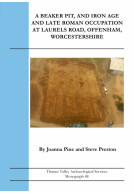Google Books previews are unavailable because you have chosen to turn off third party cookies for enhanced content. Visit our cookies page to review your cookie settings.
Iron Age and Roman enclosure with New Forest pottery kilns at Plumley Wood Quarry, Harbridge, Ringwood, Hampshire. (Paperback)
Imprint: Thames Valley Archaeological Services
Series: TVAS Monograph Series
Pages: 174
ISBN: 9781911228530
Published: 29th December 2020
Script Academic & Professional
Series: TVAS Monograph Series
Pages: 174
ISBN: 9781911228530
Published: 29th December 2020
Script Academic & Professional
Usually available in 6-8 weeks.
You'll be £20.00 closer to your next £10.00 credit when you purchase Iron Age and Roman enclosure with New Forest pottery kilns at Plumley Wood Quarry, Harbridge, Ringwood, Hampshire.. What's this?
+£4.99 UK Delivery or free UK delivery if order is over £40
(click here for international delivery rates)
Order within the next 1 hour, 47 minutes to get your order processed the next working day!
Need a currency converter? Check XE.com for live rates
(click here for international delivery rates)
Order within the next 1 hour, 47 minutes to get your order processed the next working day!
Need a currency converter? Check XE.com for live rates
The first phase of archaeological excavations in advance of quarrying revealed densely packed evidence for use of the area over four or five periods, apparently with little or no continuity between phases. The earliest occupation took the form of two post-built roundhouses, tentatively dated to the early Iron Age which were succeeded in the middle Iron Age by ring-gully type roundhouses set amidst a very loosely structured field system. The site changed dramatically in the Late Iron Age with the creation of a concentric (double or triple) ditched trapezoidal enclosure housing two large circular structures (one of those itself concentric) and with a small rectangular structure interpreted as a shrine set beyond it to the east, and perhaps another roundhouse south of that. There was apparently then a significant break, with no early Roman activity on the site. In the middle Roman period, the area of the former enclosures was occupied by rectangular buildings and incorporated into a rectilinear field system. This field system was modified in successive phases into the late Roman period and while the layout then changes little in its fundamentals, the use of the site changes again quite substantially, with the creation and use of three or four kilns for the manufacture of New Forest Roman pottery. These phases of site use also see more developments of the field system, and larger buildings. Apart from the obvious evidence for pottery production, there was some (slight) evidence for the usual small-scale iron-working expected on a Roman rural site (smithing, with no evidence for production) and the presence of querns shows the processing of cereals. Other evidence for the economy of the site (either as a producer or a consumer site) was scant, with few finds in other categories, no animal bone surviving and few charred plant remains, with the exception of one late Roman posthole which produced hundreds of charred cereal grains, including barley, wheat and specifically spelt, so that an arable component to the economy can be envisaged.
Other titles in the series...
Other titles in Thames Valley Archaeological Services...










